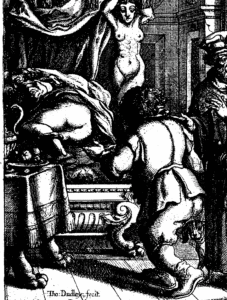A few weeks ago, in late August, I went on one of the most pleasant and thought-provoking research trips I’ve taken recently. Lampeter is a small Welsh town set amid beautiful rolling hills (then somewhat parched after the heatwave of the early summer). It also has a historic University library, founded in the early nineteenth century, which includes among its collections a small but fascinating corpus of early Aphra Behn materials.
Among Lampeter’s Behn holdings is a copy of Aesops Fables (1687). Like many of the library’s early printed books, Aesops Fables was acquired through donation from the educational philanthropist Thomas Phillips (1760-1851). Phillipps, who had also worked as an East India company surgeon, probably did not set out to collect Aphra Behn but procured her works almost by accident, in the course of adding to his ever-growing library. If he was attracted by anything in particular in Aesops Fables, it is likely not to have been Aphra Behn’s poetic versions of the fables – physically, a small component of a large and complex volume – but rather Francis Barlow’s finely executed animal engravings, which are now recognised as a landmark achievement in seventeenth-century book illustration. Although Aesops Fables, compared with many early modern books, is not rare – the British Library alone holds four copies – Lampeter’s copy is remarkably well-preserved, including all the prefatory material in what seems to have been the original order. It does not, however, include plate 17 from the illustrated ‘Life of Aesop’, an image excised from several extant copies on grounds of supposed obscenity (it depicts Aesop’s master’s wife with her buttocks exposed). Whether Aphra Behn wrote the (unattributed) four-line poems accompanying each of the ‘Life’ illustrations, as well as the six-line fables that Barlow explicitly attributed to her in his preface, is among the questions that the Cambridge Behn project hopes in time to be able to answer.

Section of Plate 17. Image from Early English Books Online.
Lampeter’s other Behn holdings comprise political poems: two dating from 1685 (her elegy on Charles II and consolatory poem to Catherine of Braganza), and two from 1689 (A Congratulatory Poem to Her Sacred Majesty Queen Mary, upon her arrival in England and A Pindaric Poem to the Reverend Doctor Burnet). The poem to Gilbert Burnet – propagandist for William of Orange, and future Bishop of Salisbury – is a rare survival, one of only seven copies now known to be extant. I regret to report that I may have been the first person in its 329-year history actually to read the Lampeter witness, as its pages had never been cut.
Lampeter’s copy of the Pindaric to Burnet is preserved in a collection of tracts and other short publications mainly dating from the 1680s. These include, at the end of the volume, another rare – in this case, anonymous – survival. A Congratulatory Poem to his Royal Highness the Prince of Orange, on his Happy Arrival (1689) is, as the title suggests, a welcome poem for William of Orange, albeit written from a politically cautious perspective. James II, ousted by William, is described as ‘Great James, by Nature good’, while his political mistakes are blamed on the ‘wicked Counsels’ of ‘wicked Men’. As William is consistently alluded to as prince rather than king, the poem is likely to predate the Convention parliament’s decision, in February 1689, to name him and his wife Mary as joint monarchs. The poem is, however, consistently and enthusiastically pro-William, describing him as ‘mighty’, ‘Illustrious’ and ‘brave’, and predicting that, under his leadership, the ‘sleeping Genius’s’ of England and Ireland will reawaken and advance to victory in France and beyond.

‘King William III of England, also known as William of Orange.’ by Abraham Blooteling. Credit: Wellcome Collection. CC BY
The political sentiments of A Congratulatory Poem to his Royal Highness are strikingly divergent from the pro-Stuart and pro-James loyalties consistently asserted by Aphra Behn throughout the 1680s and rearticulated after the Williamite invasion in the Pindaric to Burnet. So it comes as something of a surprise to see, at the end of the poem, an advertisement for Behn’s The History of the Nun, said to have been ‘lately published’. On one level, of course, the inclusion of this advertisement means nothing more than that Anthony Baskerville, the bookseller responsible for both the Congratulatory Poem and The History of the Nun, was taking advantage of the opportunity to advertise his wares. One might wonder how many readers of A Congratulatory Poem – assuming they endorsed its sentiments – would be interested in buying a work by the Stuart loyalist Aphra Behn, but perhaps Restoration readers were less politically discriminating than we sometimes think.
The inclusion of A Congratulatory Poem to his Royal Highness in the same volume as the Pindaric to Burnet is not in itself significant, as it almost certainly dates from a period long after Behn’s lifetime. But it did make me think about how we understand Behn’s late career – and, in particular, about the importance of recognising and allowing for possible gaps in our knowledge about her. Behn’s Pindaric to Burnet has traditionally been read by Restoration scholars as an ironic but unequivocal rejection of an invitation from Burnet that she change sides and write in favour of the new regime. It is certain at least that no pro-William publications explicitly attributed to Aphra Behn have ever been discovered. But is it safe to conclude from this that she never, in fact, wrote in support of William? As a professional writer for hire, might she have been willing to write for him anonymously, deploying the Pindaric to Burnet as face-saving cover?
I am not, I should emphasise, making the argument that Aphra Behn did write A Congratulatory Poem to his Royal Highness. It is not clear that the chronology of composition (compared with the Pindaric to Burnet) would be feasible, and the poem is in any case a rather pedestrian affair, by no means matching Behn’s characteristic standards of wit and ingenuity. But would we really expect Behn to write at her best in support of a cause – the Williamite invasion and consequent regime change – which she did not believe in and which represented the frustration and failure of her own long-held political loyalties? Might A Congratulatory Poem to his Royal Highness have been second-rate poetry for a worse than second-rate cause?
These questions raise important issues about the role of bias and expectation when issues of literary attribution are considered. While one cannot hope to eliminate bias altogether, a responsible scholar needs to be aware of her own assumptions and priorities and should try to ensure that her conclusions do not outstrip the historical and textual evidence. I look forward to hearing what my colleagues Mel Evans and Alan Hogarth, who are undertaking a computational stylistics analysis of attribution issues relating to Behn’s poetry, have to say about A Congratulatory Poem to his Royal Highness.
My thanks to Ruth Gooding and her colleagues at Lampeter for making me so welcome during my visit to the library.
Recent Comments